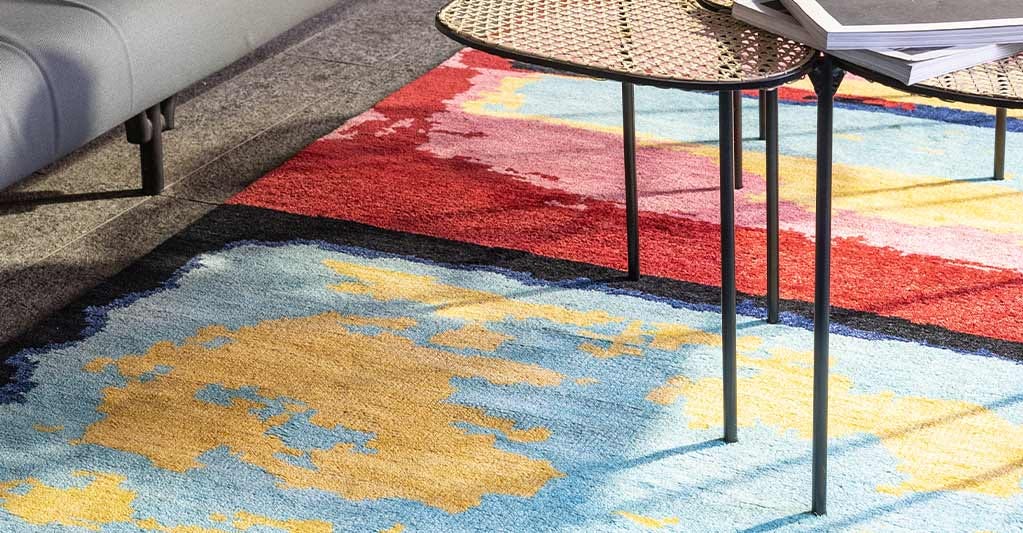Hand Knotted vs. Hand Tufted: Which Indian Rug Technique Suits Your Project?

Choosing a rug might sound simple until you realize how many different ways a rug can be made. And when it comes to Indian rugs, two techniques stand out more than any others: hand-knotted and hand-tufted. At first glance, they may even look similar. But dig a little deeper, and you'll see they’re worlds apart in how they're made, how they wear, how much they cost, and even how they feel underfoot.
Whether you're an interior designer sourcing for a boutique hotel or simply redoing your own space, understanding the difference can help you make a better decision. One that fits not just the room, but also the rhythm of how it’s used.
Let’s take a closer look.
The Art of Hand-Knotting: Precision, Patience, and Personality
If you’ve ever run your fingers across a luxury rug and felt a sense of weight or presence, it was probably hand-knotted. This technique is ancient. Time-consuming. A little obsessive, to be honest. Each knot is tied by hand, one at a time, around the warp threads on a loom. And when we say “each,” we mean tens of thousands. Sometimes hundreds of thousands.
This method takes time. Sometimes months, depending on the size and complexity. But the result? A rug with structure,softness, and longevity. One that doesn’t just lie there it lives with you. Wears in, not out.
It’s no wonder that Indian hand-knotted rug suppliers are considered among the best in the world. Many operate from places like Bhadohi or Jaipur, where artisans have been passing down the craft through generations. It's not just about traditional thought here's a lot of that. It's about skill. Muscle memory. Knowing how tight to pull the yarn so the knot holds, but doesn’t strain.
Hand-knotted rugs are ideal for spaces that you want to feel timeless. Living rooms, hotel lobbies, master bedrooms. They carry a certain gravity, a quiet kind of luxury that doesn’t shout, but definitely doesn’t go unnoticed.
What About Hand-Tufted Rugs?
Now, let’s flip to the other side of the loom.
Hand-tufted rugs are made with the help of a tufting gun a handheld tool that punches yarn into a canvas stretched over a frame. It’s still handmade, but with a faster rhythm. Once the design is complete, a backing is glued on to hold the tufts in place, and the rug is trimmed, washed, and finished.
The big difference here is time. What takes a hand-knotted rug three months might take a hand-tufted rug three weeks.
But here’s the thing, faster doesn’t always mean lesser. Many hand-tufted rug manufacturers in India create beautifully detailed designs, often at a much lower cost than their knotted counter parts. They're fantastic for clients with tighter timelines, or for projects where visual impact is more important than heir loom longevity.
We’ve seen them work brilliantly in office settings, commercial lounges, kids’ rooms places where you still want warmth and texture but maybe not the same kind of permanence.
So, Which One Is Right for You?
That depends on what you're prioritizing.
If you're designing a long-term space, where the rug is part of the investment go hand-knotted. The durability is unmatched. With care, a good hand-knotted rug can last for decades, sometimes even passed down. It will shift slightly over time. Settle. Break inlike a favorite chair.
But if you’re working with a client who's more budget-conscious or you need multiple rugs in a short time frame then hand-tufted could be the better fit. You’ll still get depth and detail, but with less time and cost commitment.
Honestly? There’s no clear winner.They serve different purposes. And that’s kind of the beauty of it.
Let’s Talk Texture, Finish, and Feel
Here’s something you might not expect: sometimes, people prefer the feel of a tufted rug. It can be plusher. Softer underfoot. Especially when made with dense wool or blends. Hand-knotted rugs, depending on the knot count, can feel firmer, even slightly uneven at first. Not in a bad way just different.
Also, the patterns you can achieve with tufting can get wild. Abstract, graphic, experimental. That’s why manymodern designers lean toward hand-tufted rug manufacturers for boldstatement pieces.
Meanwhile, a hand-knotted rug has a quieter sophistication. The dye varies slightly across the weave. The pattern might blur in places. And somehow… that feels more human. More lived-in.
What About Sustainability?
This is where it gets a little tricky.
Because both types can be made sustainably or not. It depends less on the method and more on the maker. Some Indian hand-knotted rug suppliers use ethically sourced wool, natural dyes, and fair-wage labor practices. The same goes for some tufted rug makers. The best ones are transparent about their sourcing and their values. If this matters to you (and we think it should), ask questions. Read the labels. Look beyond the price tag.
A well-made hand-knotted rug that took months to weave using responsibly sourced wool? That’s not just a product.That’s a piece of slow design.
Final Thoughts (and a Gentle Nudge)
Choosing between these two rug types is less about right and wrong and more about fit. Fit for the space. Fit for the purpose. Fit for the client.
If you're still unsure, start by reaching out to trusted partners. Many Indian hand-knotted rug suppliers and hand-tufted rug manufacturers (like Sova Rugs, for example) offer personalized consultations. You can even request samples, view digital mockups, or discuss material options before making a final decision.
In the end, whether you go tufted or knotted, you’re supporting something real. Something handmade. And in a worldfull of fast things, that still counts for a lot.
Want to explore deeper or compare styles side by side?
Check out our full rug design library or contact our team to talk through your next project.


